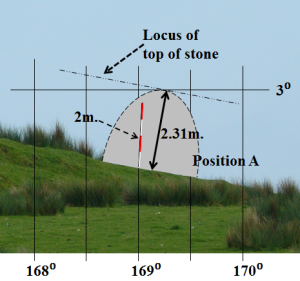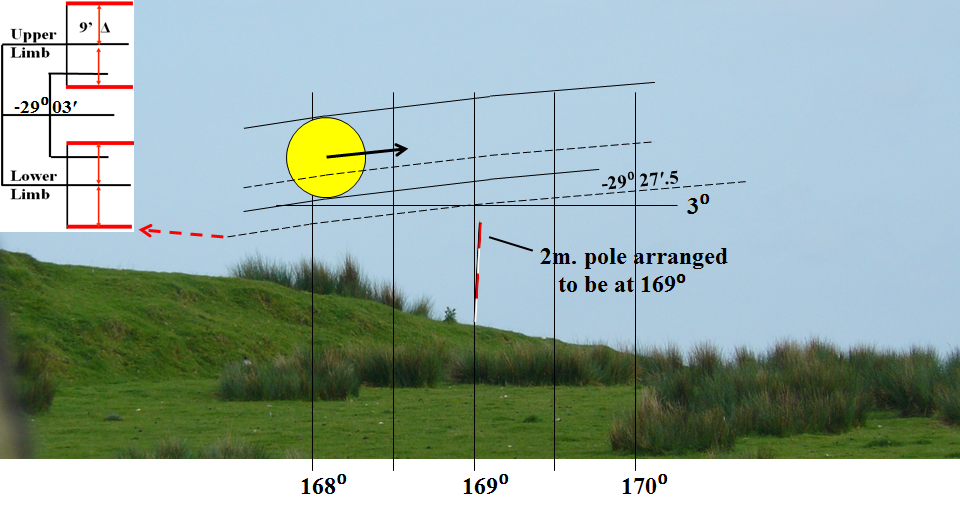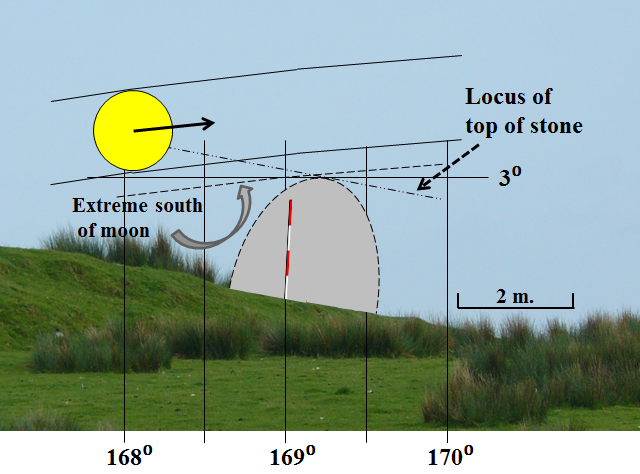#29 ACHNABREAC: NR 8554 9018 and NR 8563 8993
Thom A2/19, Ruggles AR31
Note: All sites with horizons nearer than 1 km. (as here) must be treated with caution. This applies particularly to these two sites. Having said that these results are offered for the record.
Two stones some 277m apart, the first fallen to the west and 4.5m long, the second to the SSE upright on a N/S bank and 2.5m x 1.0m x 0.3m, oriented towards the first and at a slightly higher elevation
While vegetation interferes, the top of the Foresight Stone is visible from the Backsight stone.
As with Carnasserie the supposed alignment at 277m. is unusually short. In an attempt to determine the sensitivity of the alignment relative to the observing position (including height of eye), a set of measurements were made as follows:-
 The declination of the top of the Foresight Stone was determined independently from each of the 6 grid positions:-
The declination of the top of the Foresight Stone was determined independently from each of the 6 grid positions:-
Discussion
Lateral movement. When the moon is in the south, its path is relatively 'flat' and so the declination observed becomes relatively insensitive to changes in observing position. (OP). To achieve a precision of 1' of arc, the OP left/ right would need to be correct to about 0.35m. or a little over a foot. The grid results suggest that an OP close to #1 or #4 is most likely with #3 & #6 unlikely. This is consistent with the fallen stone's present position, though knowledge of the stone hole position would be useful.
Change in elevation
The declination is much more sensitive to changes in elevation; particularly so with the moon in the south. Consistency by the observer(s) would be important, particularly during any given standstill. (See note). Height of eye would be important but this must have been appreciated by anyone who was capable of setting up such an alignment.
Note:- The topic of height of eye is discussed further after the discussion of Carnasserie
#19 CARNASSERIE Thom A2/6, Ruggles: AR12 NM8345 0080
 Two stone slabs ( 2.4m x 1.2m x 0.4m and 2.3m x 1.5m x 0.4m ) on open ground about 0.5km west of Carnasserie castle. The southern stone leans slightly to the east. The line of the west sides at ground level is close to 170°/350°. There can be no alignment to the north. To the south the horizon in the indicated direction is close. Less than 180m, where there is a 'whaleback' ridge about 100m long oriented about NE to SW with the indicated point on it towards the SW end. At this point and just over the hidden south side of the ridge is a large shattered (fallen?) block. The ridge is composed of friable rock with only a thin (5cm) covering of turf on it, and the block has what appears to be a flat end (base?). It seems possible that it once stood on the ridge. If the block (2.65m high, 2.8m wide, 1.0m thick) had sat on the ridge as suggested (at 176m) then measurements show that the top of it as viewed from just behind the stones would be an alignment for the extreme southern declination of the moon providing the sighting height was controlled.
Two stone slabs ( 2.4m x 1.2m x 0.4m and 2.3m x 1.5m x 0.4m ) on open ground about 0.5km west of Carnasserie castle. The southern stone leans slightly to the east. The line of the west sides at ground level is close to 170°/350°. There can be no alignment to the north. To the south the horizon in the indicated direction is close. Less than 180m, where there is a 'whaleback' ridge about 100m long oriented about NE to SW with the indicated point on it towards the SW end. At this point and just over the hidden south side of the ridge is a large shattered (fallen?) block. The ridge is composed of friable rock with only a thin (5cm) covering of turf on it, and the block has what appears to be a flat end (base?). It seems possible that it once stood on the ridge. If the block (2.65m high, 2.8m wide, 1.0m thick) had sat on the ridge as suggested (at 176m) then measurements show that the top of it as viewed from just behind the stones would be an alignment for the extreme southern declination of the moon providing the sighting height was controlled.
(Note There are some stones that fall in such a way that it would be hard to be reasonably confident where the stone would have stood without a proper excavation. But in some cases it is clear where the stone would have stood and what its orientation would have been. In these cases I have taken the liberty of "reconstructing" the site. (As we will see there are doubts regarding the exact position where the Carnasserie foresight stone is presumed to have stood, but the evidence that it was the foresight for a lunar alignment is considered to be significant.)
This applies to Carnasserie and to #34, 'Lower Fernoch'. )
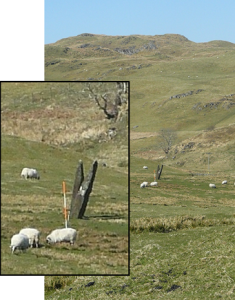
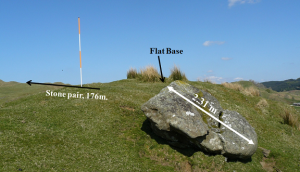
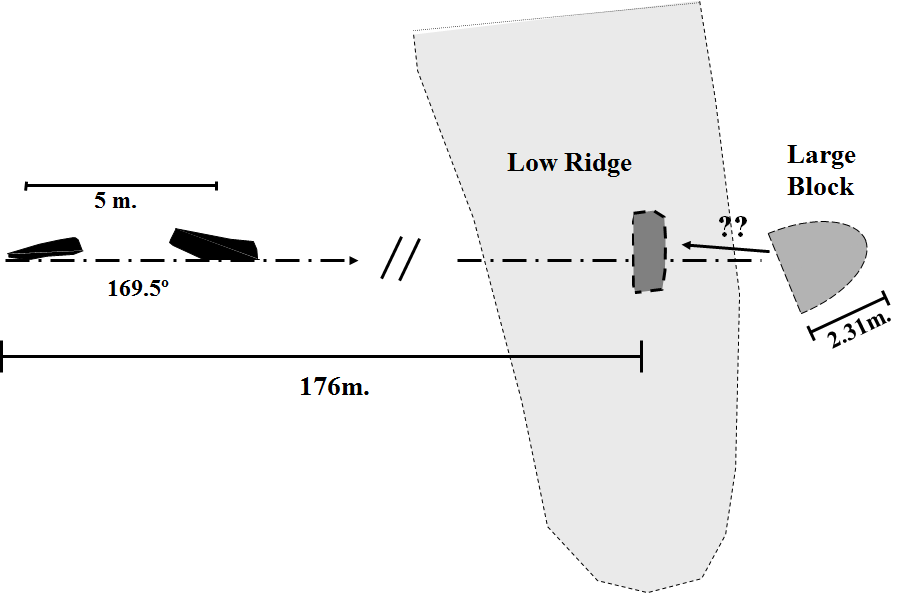
Assuming that the stone/ block once stood on the rocky ridge, then the exact position would be important. All that we can do is to show the range of location where it would be necessary to have stood for a presumed eye height (1.5m. ) and in order that the declination of the top of the stone was within ±2’ of arc of a key theoretical value.
We now consider the the lunar path compared with the locus of the stone top:-
Based on the assumptions stated above - mainly re eye height - we have a range of position for the stone:-
Based on the requirement that a precise alignment should be within 2′ of arc of a theoretical value, the top of the stone would need to be in the range shown above. i.e. between 169°.0 and 169°.25 which corresponds to a distance of 0.8m. - based, of course, on the assumption of eye height of 1.5m. A change of eye height of 10cm. would give a change of 2′ of arc.
It must be noted that the fallen stone is not exactly in line with the possible position shown above, but is about 1 m. to the right. The top rather less at about 0.5m - the stone may have slewed slightly in falling.
In the past it has generally been considered that any alignment of less than 1km. is suspect, let alone only 176m. However there are factors that tend to reduce the uncertainties in use. The path of the moon in the south is nearly 'flat' and so the measurement is relatively insensitive to lateral movement. The indication is fully adequate. As for Achnabreac if the eye height is carefully controlled, the arrangement here would be viable
Lunar visibility. The 3rd quarter moon would be rising in near darkness or deep twilight. However for the 1st quarter moon the sun would not yet have set. It would have been low in the western sky but behind a steep hill close by to the west. Thus observations at this time would probably have been possible.
Note:-
(1) On the assumption that the observers were interested in the time (i.e. day) of the maximum (or minimum) of the 'wobble', then the actual position (now we would say declination) of the moon during this time would not have been of great importance. At a site such as Achnabreac or Carnasserie, as long as the observers were consistent with regard to observing position, it would matter little if they had the moon a little too high or a little too low.
(2) Bearing in mind what is said above, it is suggested that such a short alignment would only be a practical possibility for the moon in the south.
Conclusion:- with regard to validity the two sites Achnabreac and Carnasserie support each other:-
- Both are of comparable length
- Both have an artificial foresight
- The foresight stone at Achnabreac is aligned on the backsight
- The size of the Achnabreac backsight stone suggests that this was an important site
- In each case there is no possibility of any other alignment
- They are for opposite 'wobble' (Crests about 86 days apart)
- They are in the same geographical region. (11km apart)
- Both are close to Nether Largie, a site for which Thom provided evidence for the belief that it was a lunar observatory.
- Re the Carnasserie presumed fallen stone, there are no other stones of significant size nearby.
It is concluded that while care would have required in making the necessary observations, such observations would have been entirely possible. I.e. that the sites were set up for the purpose of observing the moon's 'wobble' as part of a wider network of lunar alignments/observatories






